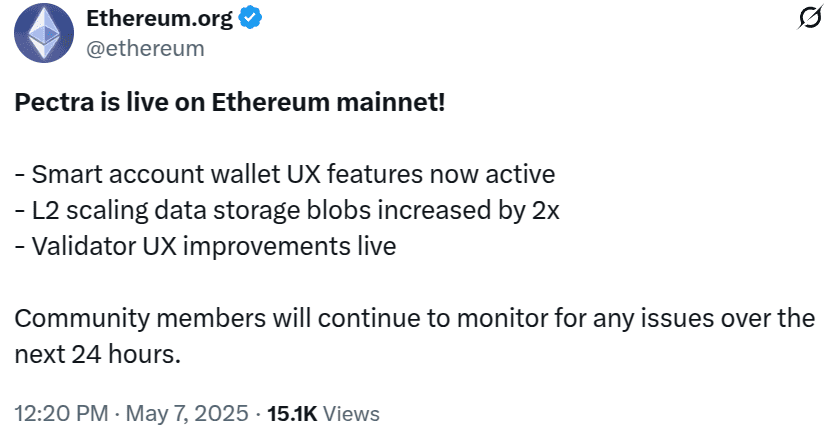Ethereum’s highly anticipated Pectra upgrade went live on May 7, 2025, marking a significant step forward in the evolution of the blockchain network. This upgrade introduces several key improvements designed to enhance user experience, improve scalability, and streamline institutional staking. Let’s delve into the details of what Pectra brings to the Ethereum ecosystem.
Key Features of the Pectra Upgrade
The Pectra upgrade incorporates several Ethereum Improvement Proposals (EIPs) that address critical aspects of the network. The main EIPs included are EIP-7702, EIP-7251 and EIP-7691. Here’s a breakdown of the most important updates:
- EIP-7702: Smart Account Functionality: This EIP allows externally owned accounts (EOAs) to temporarily act as smart contracts during a transaction. This enables features like gasless transactions and more flexible user flows.
- EIP-7251: Increased Staking Limits: EIP-7251 increases the maximum validator staking limit from 32 ETH to 2,048 ETH. This change simplifies operations for large stakers and encourages more participation in network validation.
- EIP-7691: Enhanced Layer-2 Scalability: This EIP increases the number of data blobs per block, which improves the scalability of layer-2 solutions built on Ethereum. This can potentially lead to significantly reduced transaction fees for users.
- EIP-6110: Validator Deposit Updates: This update improves the speed and efficiency of validator deposits to the consensus layer by including deposit information directly in execution-layer blocks.

Impact on User Experience
One of the most significant impacts of Pectra is the potential for a smoother and more user-friendly experience. With EIP-7702, users can benefit from:
- Gasless Transactions: Users may no longer need ETH to pay for transaction fees, opening the door to transactions paid in other ERC-20 tokens.
- Simplified User Flows: The ability for EOAs to act as smart contracts allows for more complex and automated interactions, removing the need for multiple approvals and signatures.
- Improved Security: Enhanced permission and delegation systems can limit the abilities of apps interacting with wallets, reducing the risk of malicious actors.
Scalability Improvements
Pectra addresses Ethereum’s scalability challenges by improving layer-2 solutions. By increasing the number of data blobs per block, EIP-7691 allows layer-2 networks to process more transactions efficiently, which ultimately lowers transaction costs for users. This is crucial for Ethereum to handle a growing number of users and applications.
Enhanced Institutional Staking
EIP-7251 and EIP-6110 collectively make institutional staking easier and more secure. The increased staking limit simplifies operations for large stakers, while improvements to validator deposit processing streamline the onboarding of new validators to the network. This promotes greater participation in Ethereum’s staking protocol, strengthening network security.
Potential Security Considerations
While Pectra brings numerous benefits, some security concerns have been raised. EIP-7702 introduces the possibility of new attack vectors, where malicious actors could trick users into signing harmful messages. However, experts believe that the industry is well-equipped to address these challenges with secure contract design and robust security practices.
The Future of Ethereum with Pectra
The Pectra upgrade represents a significant step forward for Ethereum, unlocking new possibilities for user experience, scalability, and institutional adoption. By embracing these changes, Ethereum is positioning itself to remain a leading blockchain platform in the years to come. While potential security concerns exist, the Ethereum community is actively working to mitigate risks and ensure a safe and user-friendly ecosystem.
As Ethereum continues to evolve, upgrades like Pectra will be essential for driving innovation and expanding the reach of decentralized technologies. The focus on user experience, scalability, and security will shape the future of the network and its impact on the broader blockchain landscape.